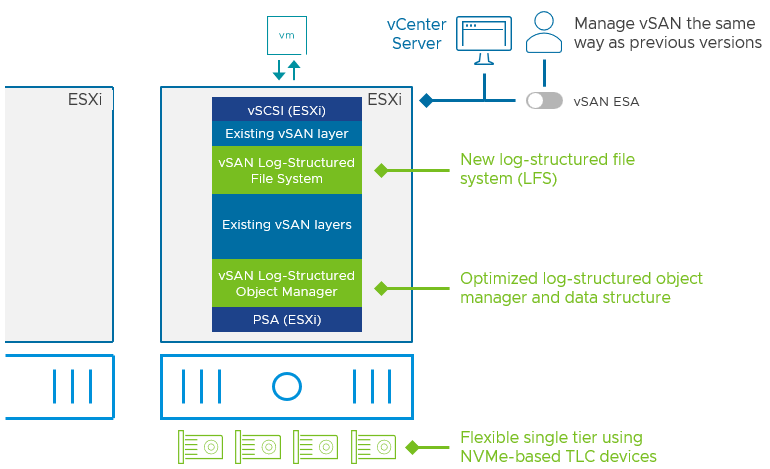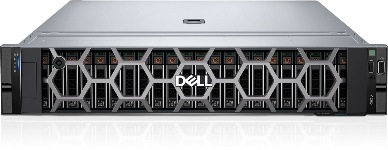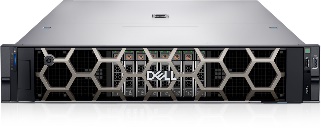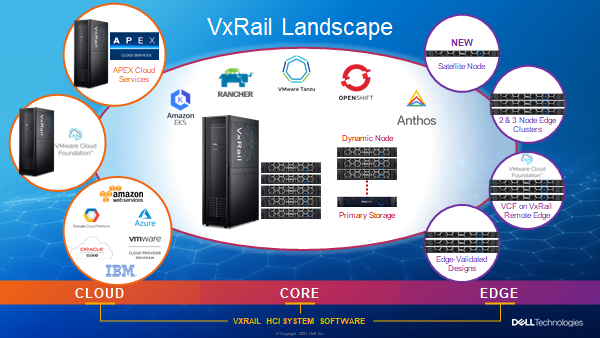Assets

Dell Technologies vSAN ReadyNode Certification Guide Part II
Fri, 13 Oct 2023 14:50:27 -0000
|Read Time: 0 minutes
Dell and VMware collaborate to streamline and expedite the integration of software and hardware, enabling the delivery of tailored solutions for your business requirements. Leveraging our strong partnership, Dell vSAN Ready Nodes provides the latest versions of VMware vSphere®, VMware vSAN™, and VMware Cloud Foundation as soon as they become available. The introduction of VMware vSAN 8.0 - Express Storage Architecture, along with support for stretched clusters and expanded disaggregated storage capabilities, marks a significant milestone. In the ongoing development of vSAN 8 Update1, both vSAN OSA and vSAN ESA architectures are continuously improved and enriched with additional features, such as efficient data services and an optimized architecture for NAND Flash utilizing NVMe as the protocol bus. As vSAN 8 introduces groundbreaking updates that enhance performance and efficiency, this paper delves into the key factors that contribute to Dell vSAN ReadyNode as a differentiated but compatible certified hardware.
Dell vSAN Ready Nodes are x86 servers built on the Dell PowerEdge portfolio of Intel and AMD processors-based servers, which have been pre-configured, tested and certified for VMware Hyper-converged Infrastructure.
For more information on Dell vSAN ReadyNodes Certification, visit https://infohub.delltechnologies.com/p/dell-emc-vsanready-node-certification/.
vSAN OSA and ESA
vSAN Original Storage Architecture
vSAN is a software-defined storage solution built from the ground up for VMware vSphere Virtual Machines and containers. This solution abstracts and aggregates the server’s local disks in a vSphere cluster to create a storage solution that is provisioned and managed from the vCenter. As vSAN is embedded within the vSphere hypervisor, compute and storage for the VMs and containers are delivered from the same Dell PowerEdge server platform running the hypervisor.
vSAN original storage architecture consists of two tiers: a cache and a capacity tier. The cache tier performs read caching and write buffering, and the capacity tier functions as persistent storage. vSAN uses disk groups to manage the relationship between cache and capacity tiers. Each host contributing storage (either an All-Flash or a Hybrid Configuration of magnetic disks and flash drives) to a vSAN cluster will consist of at least 1-disk group that contains one cache device and between one and seven capacity devices. Whether hybrid or all-flash configuration, the cache drive must be a flash drive. vSAN uses the cache device for both a read/write cache (70%/30%) in a hybrid configuration, and in an all-flash configuration, the cache device is dedicated (100%) as a write cache.
VMware vSAN OSA ReadyNode configuration with Cache & Capacity Tiers
vSAN OSA AF-6 Dell PowerEdge R760 | ||
Generation: Intel Xeon Scalable (Sapphire-Rapids-SP) - Profile: AF-6 Series - Raw Storage Capacity: Up To 38.4 TB | ||
Components | Details | Qty |
ESXi Pre-Installed? | Yes |
|
System | PowerEdge R760 | 4 |
CPU | Intel Platinum 8470 2.00 GHz 52 Core | 8 |
Memory | DIMM,32GB,4800,2RX4,16G, DDR5R | 64 |
Caching Tier | 800GB Solid State Drive SAS Mixed Use 24Gbps 2.5 inch Hot-Plug Drive | 16 |
Capacity Tier | 1.92TB SSD SATA 6Gbps 2.5in SE5031 | 80 |
Controller | HBA355i Front | 4 |
NIC | Intel(R) Ethernet 25G 2P E810-XXV OCP | 4 |
Boot Device | BOSS controller card + with 2 M.2 Sticks 240G (RAID 1) or higher | 4 |
Supported Releases | ESXi 8.0 U1 (vSAN 8.0 Update 1), ESXi 8.0 (vSAN 8.0), ESXi 7.0 U3 (vSAN 7.0 Update 3) | 4 |
Table 1. vSAN OSA ReadyNode Configuration
vSAN Express Storage Architecture
vSAN Express Storage Architecture is an alternative architecture that builds on the existing Original Storage architecture. Compared to OSA which is a two-tier architecture, the ESA architecture is single-tiered, optimized for high performance NVMe-based flash devices for both on-premises and cloud environments. Some of the structural changes include a new Log-Structured Filesystem-LFS, a write optimized log-structured object manager, a new native snapshot engine, and a new object format. Some of the achievements of the new capabilities are space efficiency of RAID 5/6 erasure coding with the performance of RAID-1, Adaptive RAID-5 erasure coding for space savings on clusters with as few as 3-hosts, HCI Mesh support for 10-client cluster, lower TCO by removing dedicated cache devices by using a single-tier, simplified management, and smaller failure domains by removing construct of disk groups. Customers can now choose the best architecture for their hardware while building new clusters with unprecedented levels of performance. Finally, vSAN Express Storage Architecture is available as new deployments, and an existing cluster cannot be upgraded to vSAN ESA.

Fig.1. Integrating optional hardware optimized architecture in vSAN
VMware vSAN ESA ReadyNode configuration with a single tier
vSAN ESA AF-6 Dell PowerEdge R760 | ||
Generation: Intel Xeon Scalable (Sapphire-Rapids-SP) Profile: vSAN-ESA-AF-6 Raw Storage Capacity: Up To 51.2 TB | ||
Components | Details | Qty |
System | PowerEdge R760 | 4 |
CPU | Intel Platinum 8462Y 2.80Ghz 32 Core | 8 |
Memory | 64GB DDR-4, 3200, 2RX4 ,8G, DDR4, R | 16 |
Storage Tier | Dell Ent NVMe PM1735a MU 6.4TB | 8 |
NIC | Intel(R) Ethernet 25G 2P E810-XXV OCP | 8 |
Boot Device | BOSS controller card + with 2 M.2 Sticks 120G or higher (RAID 1) | 4 |
Supported Releases | ESXi 8.0 U1 (vSAN 8.0 Update 1), ESXi 8.0 (vSAN 8.0) | 4 |
Table.2. vSAN ESA ReadyNode Configuration
Allowable changes in vSAN ReadyNodes for both OSA and ESA
Components | vSAN OSA Modifiable | vSAN ESA Modifiable | vSAN OSA Guidance | vSAN ESA Guidance |
CPU | Yes | Yes |
|
|
Memory | Yes | Yes |
|
|
Caching Tier | Yes | NA |
|
|
Capacity Tier | Yes | NA |
|
|
Storage Device | NA | Yes |
|
|
Additional Certified IO Controller | Yes | NA |
|
|
Change in Storage Protocol | No | NA |
|
|
NIC | Yes | Yes |
|
|
Boot Device Controller | Yes | Yes |
|
|
Table.3. Allowable configuration changes in vSAN ReadyNodes
For detailed FAQs on VMware vSAN, visit https://core.vmware.com/resource/vsan-frequently-asked-questions-faq#section1.
Dell vSAN Express Storage Architecture ReadyNode Configuration
Components | Description | Quantity |
DellStar Quote No. | 18070029 |
|
ESXi Pre-Installed | Yes |
|
System | VSAN-RN R660 | 4 |
CPU | Intel® Xeon® Gold 6430 2.1G, 32C/64T, 16GT/s, 60M Cache, Turbo, HT (270W) DDR5-4400 | 2 |
Memory | 32GB RDIMM, 4800MT/s Dual Rank, RDIMMs | 16 |
Storage Tier | 3.2TB Enterprise NVMe Mixed Use AG Drive U.2 Gen4 with carrier | 10 |
NIC | Broadcom 57414 Dual Port 10/25GbE SFP28, OCP NIC 3.0 | 1 |
Boot Device | BOSS-N1 controller card + with 2 M.2 480GB (RAID 1) | 1 |
Table.4. An example of Dell vSAN ESA ReadyNode configuration from the Dell Configurator
VMware vSAN compatibility guide
Dell vSAN Ready Nodes for both OSA and ESA are certified hardware for building vSAN clusters. These ReadyNodes are ideal for building data center and cloud environments that deploy hyperconverged building blocks for varied scenarios. Dell Technologies provides multiple vSAN Ready Node options that are built on the Dell PowerEdge servers and support multiple vSAN editions and versions till the latest vSAN 8 U1. Dell Technologies provides a wide range of options for selecting the vSAN server model and storage controller as well as magnetic disks, SAS SSD, NVMe, NIC controllers, and accelerators, combined with VMware ESXi for both OSA and ESA configurations. There are multiple ReadyNode options available for different performance and workload requirements.
Dell vSAN OSA Guide > https://www.vmware.com/resources/compatibility/pdf/vi_vsan_rn_guide.pdf
Dell vSAN ESA Guide > https://www.vmware.com/resources/compatibility/pdf/vi_vsanesa_guide.pdf
Dell Technologies and VMware strongly recommend using tested and certified ReadyNodes that are validated to provide predictable performance and scalability when building a vSAN Cluster. Dell Technologies provides varied options for vSAN ReadyNodes for both Original Storage Architecture and Express Storage Architecture. To configure a Dell vSAN ReadyNodes listed for ESA solution, visit https://www.vmware.com/resources/compatibility/search.php?deviceCategory=vsanesa. On the configurator page 1, for ‘Choose Step 1’, select the vSAN ReadyNode Vendor as Dell. Next, choose the ‘vSAN ESA Server Model’ and processor vendor from a range of validated and certified 15G and 16G server models and processor from Intel or AMD. Next, choose the ‘ReadyNode Profile’ from AF-0 to AF-8. Once the required options are chosen, click on ‘Configure vSAN ESA ReadyNode.’ In Step 2, for ‘Configure’, select host configuration of sockets, cores, memory, storage type, number of storage devices, capacity, network speed, and number of network adapters. Next, click Step 3 to ‘Consume’. The configurator then builds the configuration chosen as per the requirements for the solution.
Note: There is only one storage tier in vSAN ESA configuration, unlike OSA configuration that requires two types of disks for cache and capacity tiers.
Dell Technologies PowerEdge 16th Generation vSAN ESA ReadyNodes.
Dell Technologies vSAN ESA Ready Nodes | ||||||||
Server | PowerEdge R660  | PowerEdge R760  | PowerEdge R760xa  | |||||
CPU | 2 Sockets, 72 Cores Intel Xeon Scalable (Sapphire Rapids-SP) | 2 Sockets, 72 Cores Intel Xeon Scalable (Sapphire Rapids-SP) | 2 Sockets, 32 Cores Intel Xeon Scalable (Sapphire Rapids-SP) | |||||
Memory | 1024 GB 32 DDR5 DIMM slots, supports RDIMM 8 TB max, speeds up to 4800 MT/s | 1024 GB 32 DDR5 DIMM slots, supports RDIMM 8 TB max, speeds up to 4800 MT/s | 512 GB 32 DDR5 DIMM slots, supports RDIMM 8 TB max, speeds up to 4800 MT/s | |||||
Storage | 10 x 6.4 TB Dell U.2 Ent NVMe PM1735a MU 6.4 TB [3 DWPD] | 16 x 6.4 TB / 24 x 3.2 TB Dell Ent NVMe CM6 MU 6.4 TB [3DWPD] Dell U.2 Ent NVMe P5620 MU 3.2 TB [3 DWPD] | 6 x 3.2 TB Dell Ent NVMe CM6 MU 3.2 TB [3DWPD]
| |||||
Network Speed Host NIC | 2 x 100 Gb
1 | 2 x 100 Gb
1 | 1 x 25 Gb
1 | |||||
ReadyNode Profile
Available Profiles | AF-8
AF-0, AF-2, AF-4, AF-6 | AF-8
AF-0, AF-2, AF-4, AF-6 | AF-2
AF-0 | |||||
|
|
|
| |||||
Server | PowerEdge R6615  | PowerEdge R6625  | PowerEdge R7615  | PowerEdge R7625  | ||||
CPU | 1 Socket, 64 Cores AMD EPYC Genoa | 2 Sockets, 128 Cores AMD EPYC Milan | 1 Socket, 48 / 64 Cores AMD EPYC Genoa | 2 Socket, 128 Cores AMD EPYC Genoa | ||||
Memory | 768 GB 12 DDR5 DIMM slots, supports RDIMM 3 TB max, speed up to 4800 MT/s | 768 GB 24 DDR5 DIMM slots, supports RDIMM 6 TB max, speeds up to 4800 MT/s | 768 GB 12 DDR5 DIMM slots, supports RDIMM 3 TB max, speeds up to 4800 MT/s | 768 GB 24 DDR5 DIMM slots, supports RDIMM 6 TB max, speeds up to 4800 MT/s | ||||
Storage | 10 x 6.4 TB Dell U.2 Ent NVMe P5620 MU 6.4 TB [3 DWPD] | 7 x 6.4 TB Dell U.2 Ent NVMe P5620 MU 6.4 TB [3 DWPD] | 16 x 6.4 TB / 3.2 TB Dell U.2 Ent NVMe PM1735a MU 6.4 TB [3 DWPD] Dell U.2 Ent NVMe P5620 MU 3.2 TB [3 DWPD] | 14 x 3.2 TB Dell U.2 Ent NVMe PM1735a MU 6.4 TB [3 DWPD] Dell Ent NVMe CM6 MU 3.2 TB [3DWPD] Dell U.2 Ent NVMe P5620 MU 3.2 TB [3 DWPD] | ||||
Network Speed Host NIC | 2 x 25 Gb
1 | 2 x 25 Gb
1 | 2 x 25 Gb
2 | 2 x 25 Gb
2 | ||||
ReadyNode Profile
Available Profiles | AF-6
AF-0, AF-2, AF-4 | AF-6
AF-2 | AF-6
AF-0, AF-2 | AF-6
AF-0, AF-2 | ||||
vSAN ESA ReadyNode Hardware Guidance
When choosing the hardware, it is important to define the workload profile requirement for the use case. Once this is done, filter and search ReadyNode offerings to determine the approximate configuration that meets the defined requirement. Finally, choose the vSAN ESA ReadyNode aligned with the selected profile.
Description | vSAN-ESA-AF-0 | vSAN-ESA-AF-2 | vSAN- ESA-AF-4 | vSAN- ESA-AF-6 | vSAN- ESA-AF-8 | vSAN-ESA-AF-High- density |
Node Capacity (TB) (Min) | 3.2 | 15 | 20 | 40 | 60 | 100 |
CPU (#cores) per Node (Min) | 16 | 32 | 40 | 48 | 56 | 48 |
Memory (GB) (Min) | 128 | 512 | 512 | 768 | 1024 | 768 |
Number of storage devices (Min) | 2 | 4 | 4 | 4 | 4 | 4 |
Device Endurance | 1 DWPD or higher | 3 DWPD | 1 DWPD or higher | |||
Network (GbE) (Min) | 10 | 25 | 25 | 50 | 100 | 50 |
Device Guidance
Device Type and Protocol: NVMe TLC. The vSAN ESA ReadyNode is certified with NVMe and allows no change to the device type.
SSD Performance Class: Class F or higher, (Class F (100000 - 349999 WPS), Class G (350000+ WPS))
Endurance Class:1 DWPD or higher
Capacity:1.6TB or higher
Sizing Assumptions Used For vSAN ESA ReadyNode Profiles
Network: Dual port NIC recommended for redundancy.
Device Capacity: The capacity point is for guidance only. You can choose different capacity points as long as Node Capacity and Performance/Endurance classes are met.
Number of Storage Tier Devices: The number of Storage Tier devices has an impact on the performance of vSAN ESA. The minimum quantity is 4 devices per node. We recommend configuring more for better performance.
Dell vSAN Ready Nodes are built on trusted and proven PowerEdge Servers, speeding up the deployment with pre-configured, pre-tested configurations that are validated and certified to run VMware vSAN and help build a solution to meet an organization’s growing needs from the start. vSAN ESA ReadyNode solutions are based for different workload requirements, built for capacity and performance, and are available in the above form factors for entry, mid, and high demand workloads as specified in the Available ReadyNode profiles, from AF-0, AF-2, AF-04, AF-06 and AF-8.
Dell Technologies and VMware
As newer technologies and innovations evolve with VMware vSAN, Dell Technologies vSAN ReadyNodes ensure the pace is maintained with the newer generation of PowerEdge servers that are certified as ReadyNodes to run VMware’s latest vSAN software, providing the much-needed computing, networking, and storage requirements.
Dell Technologies and VMware provide business value to customers, delivering integrated solutions that accelerate the journey to digital transformation. Our partnership offers deep integration of VMware’s innovative technology with the unique combination of hardware and vSAN software while providing choice and flexibility to consume the latest technology. The Dell Technologies and VMware partnership provides a unique advantage, given that our infrastructure solutions are optimized for VMware solution stacks.
Author: Thomas MM, Technical Marketing Engineering, Linka Biaggi, Product Marketing

Latest Security Enhancements for VxRail– April 2022
Tue, 26 Apr 2022 15:59:16 -0000
|Read Time: 0 minutes
Dell VxRail: Comprehensive Security by Design
VxRail is the only co-engineered, fully integrated, pre-configured, and pre-tested VMware hyperconverged integrated system that is optimized for VMware vSAN. This has been the case since VxRail was launched over six years ago in February of 2016. VxRail is a truly remarkable “Better Together” story. It stands out as a testament to tight integration work, as no other vendor has gone as deep in their integration as VxRail has with vSAN.
VxRail’s simplicity, scalability, and performance, along with the ongoing rapid pace of innovation, make it a platform for data center modernization and more. One could say that VxRail helps future proof businesses. VxRail also provides a fast and straightforward path to this security transformation from Cloud to Core to Edge.

Dell Technologies created and, for years, has maintained the Dell VxRail: Comprehensive Security by Design white paper which provides an overview of VxRail security features, updates, and details about security options. Security on the VxRail is part of its DNA; it was in the foreground of the concept. Security is similar to the medical industry as it requires continuous learning, skills, and process updates. Keeping up with security demands requires users to follow these same practices, and there is always more that can be done.
The following links provide detailed information about VxRail. If you are not familiar with VxRail, use these two links to gain additional insight into the product.
- VxRail Interactive Journey — VxRail Interactive Journey provides a better way for technical buyers to get familiar with VxRail and quickly come away with what makes VxRail awesome through an immersive experience for consuming videos, podcasts, and interactive demos.
- Dell VxRail System TechBook — The TechBook is a conceptual and architectural review of the Dell VxRail, optimized for VMware vSAN. The TechBook describes how hyperconverged infrastructure drives digital transformation and focuses on the VxRail system as a leading hyperconverged technology solution.
The following list includes key security updates that are provided in the April 2022 version of the white paper:
- CloudIQ — Updates the CloudIQ section to include the rebranding from MyVxRail to CloudIQ. The switch to CloudIQ brings consistency while delivering the same quality of service across Dell Technologies solutions.
- Role Based Access Control (RBAC) — Adds the use of RBAC to keep customer data safe and with independent viewing so that customers can only view their own data.
- Ransomware — Provides new details, especially regarding the supply chain, focusing on the growth in the number of targeted attacks and business types.
- Snapshot recovery — Describes the shift to using vSAN snapshots as a means of recovery, specifically using point-in-time recovery snaps to create backups.
VxRail is the only HCI system on the market that fully integrates Dell PowerEdge Servers with VMware, vSphere, and vSAN. Because VxRail is built on our award-winning PowerEdge platform, we inherited security features native to our hardware. Additional information about security, such as these PowerEdge and VMware white papers, provides deeper and more specific security-related information about VxRail.
Note: Additional security documentation, such as the PowerEdge or VMware security papers, also provide more specific security-related information related to the products that also make up the VxRail.
- Technical White Paper: Cyber Resilient Security in Dell PowerEdge Servers —The PowerEdge paper details the security features built into in the PowerEdge Cyber Resilient Platform, many enabled by the Dell Remote Access Controller (iDRAC9).
- VMware Product Security — VMware Product Security provides an overview of VMware's commitment to building trust with the customer.
This blog is a high-level overview of some information in the newly revised security features. There is a continuous effort to enhance VxRail security landscapes. This blog is to simplify the delivery of security information and to keep it relevant for our readers.
For more information, see the Dell VxRail: Comprehensive Security by Design or the VxRail Security Infographic for a quick overview.
Additional resources
This white paper describes both integrated and optional security features, best practices, and proven techniques for securing your VxRail system from the Core to the Edge to the Cloud. | |
VxRail Interactive Journey provides a better way for technical buyers to get familiar with VxRail and quickly come away with what makes VxRail awesome through an immersive experience for consuming videos, podcasts, and interactive demos. | |
The TechBook is a conceptual and architectural review of the Dell VxRail, optimized for VMware vSAN. The TechBook describes how hyperconverged infrastructure drives digital transformation and focuses on the VxRail system as a leading hyperconverged technology solution. | |
Technical White Paper: Cyber Resilient Security in Dell PowerEdge Servers | The PowerEdge paper details the security features built into in the PowerEdge Cyber Resilient Platform, many enabled by the Dell Remote Access Controller (iDRAC9) |
VMware Product Security provides an overview of VMware's commitment to building trust with the customer |

